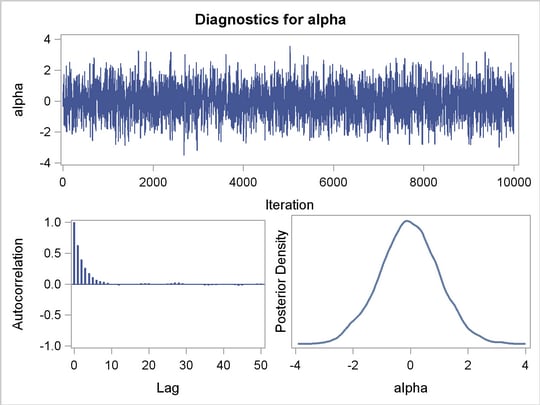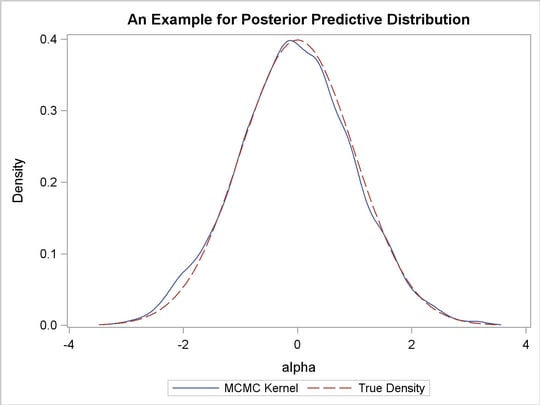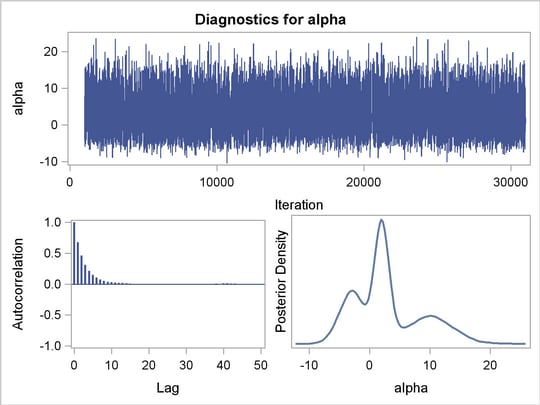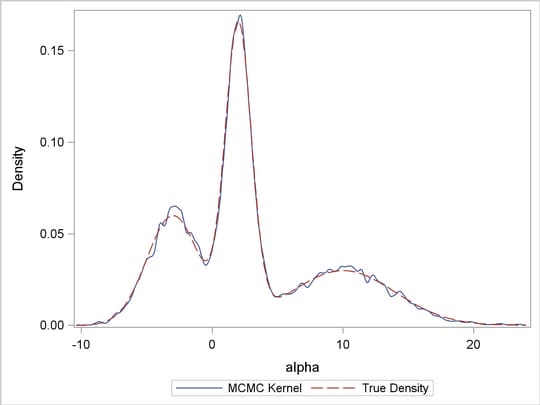| The MCMC Procedure |
Example 52.1 Simulating Samples From a Known Density
This example illustrates how you can obtain random samples from a known function. The target distributions are the normal distribution and a mixture of the normal distributions. You do not need any input data set to generate samples from a known density. You can set the likelihood function to a constant. The posterior distribution becomes identical to the prior distributions that you specify.
Sampling from a Normal Density
With a constant likelihood, there is no need to input a response variable since no data are relevant to a flat likelihood. However, PROC MCMC requires an input data set, so you can use an empty data set as the input data set. The following statements generate 10000 samples from a standard normal distribution:
data x;
run;
ods graphics on;
proc mcmc data=x outpost=simout seed=23 nmc=10000 maxtune=0
nbi=0 statistics=(summary interval) diagnostics=none;
ods exclude nobs parameters samplinghistory;
parm alpha 0;
prior alpha ~ normal(0, sd=1);
model general(0);
run;
ods graphics off;
The ODS GRAPHICS ON statement requests ODS Graphics. The PROC MCMC statement specifies the input and output data sets, a random number seed, and the size of the simulation sample. There is no need for tuning (MAXTUNE=0) because the default scale and the proposal variance are optimal for a standard normal target distribution. For the same reason, no burn-in is needed (NBI=0). The STATISTICS= option is used to display only the summary and interval statistics. The ODS EXCLUDE statement excludes the display of the NObs, Parameters and SamplingHistory tables. The summary statistics (Output 52.1.1) are what you would expect from a standard normal distribution.
| Posterior Summaries | ||||||
|---|---|---|---|---|---|---|
| Parameter | N | Mean | Standard Deviation |
Percentiles | ||
| 25% | 50% | 75% | ||||
| alpha | 10000 | -0.0392 | 1.0194 | -0.7198 | -0.0403 | 0.6351 |
The trace plot (Output 52.1.2) shows good mixing of the Markov chain, and there is no significant autocorrelation in the lag plot.


You can also overlay the estimated kernel density with the true density to get a visual comparison, as displayed in Output 52.1.3.
To create Output 52.1.3, you first use PROC KDE (see Chapter 45, The KDE Procedure ) to obtain a kernel density estimate of the posterior density on alpha, and then you evaluate a grid of alpha values by using PROC KDE output data set sample on a normal density. The following statements evaluate kernel density and compute corresponding normal density.
proc kde data=simout;
ods exclude inputs controls;
univar alpha /out=sample;
run;
data den;
set sample;
alpha = value;
true = pdf('normal', alpha, 0, 1);
keep alpha density true;
run;
Finally, you plot the two curves on top of each other by using PROC SGPLOT (see Chapter 21, Statistical Graphics Using ODS ); the resulting figure is in Output 52.1.3. You can see that the kernel estimate and the true density are very similar to one another. The following statements produce Output 52.1.3:
proc sgplot data=den;
yaxis label="Density";
series y=density x=alpha / legendlabel = "MCMC Kernel";
series y=true x=alpha / legendlabel = "True Density";
discretelegend;
run;

Sampling from a Mixture of Normal Densities
Suppose that you are interested in generating samples from a three-component mixture of normal distributions, with the density specified as follows:
 |
The following statements generate random samples from this mixture density:
data x;
run;
ods graphics on;
proc mcmc data=x outpost=simout seed=1234 nmc=30000;
ods select TADpanel;
parm alpha 0.3;
lp = logpdf('normalmix', alpha, 3, 0.3, 0.4, 0.3, -3, 2, 10, 2, 1, 4);
prior alpha ~ general(lp);
model general(0);
run;
ods graphics off;
The ODS SELECT statement displays the diagnostic plots. All other tables, such as the NObs tables, are excluded. The PROC MCMC statement uses the input data set x, saves output to the simout data set, sets a random number seed, and simulates 30,000 samples.
The lp assignment statement evaluates the log density of alpha at the mixture density, using the SAS function LOGPDF. The number 3 after alpha in the LOGPDF function indicates that the density is a three-component normal mixture. The following three numbers,  ,
,  , and
, and  , are the weights in the mixture;
, are the weights in the mixture;  ,
,  , and
, and  are the means;
are the means;  ,
,  , and
, and  are the standard deviations. The PRIOR statement assigns this log density function to alpha as its prior. Note that the GENERAL function interprets the density on the log scale, and not the original scale. Hence, you must use the LOGPDF function, not the PDF function. Output 52.1.4 displays the results. The kernel density clearly shows three modes.
are the standard deviations. The PRIOR statement assigns this log density function to alpha as its prior. Note that the GENERAL function interprets the density on the log scale, and not the original scale. Hence, you must use the LOGPDF function, not the PDF function. Output 52.1.4 displays the results. The kernel density clearly shows three modes.

Using the following set of statements similar to the previous example, you can overlay the estimated kernel density with the true density. The comparison is shown in Output 52.1.5.
proc kde data=simout;
ods exclude inputs controls;
univar alpha /out=sample;
run;
data den;
set sample;
alpha = value;
true = pdf('normalmix', alpha, 3, 0.3, 0.4, 0.3, -3, 2, 10, 2, 1, 4);
keep alpha density true;
run;
proc sgplot data=den;
yaxis label="Density";
series y=density x=alpha / legendlabel = "MCMC Kernel";
series y=true x=alpha / legendlabel = "True Density";
discretelegend;
run;

Copyright © 2009 by SAS Institute Inc., Cary, NC, USA. All rights reserved.